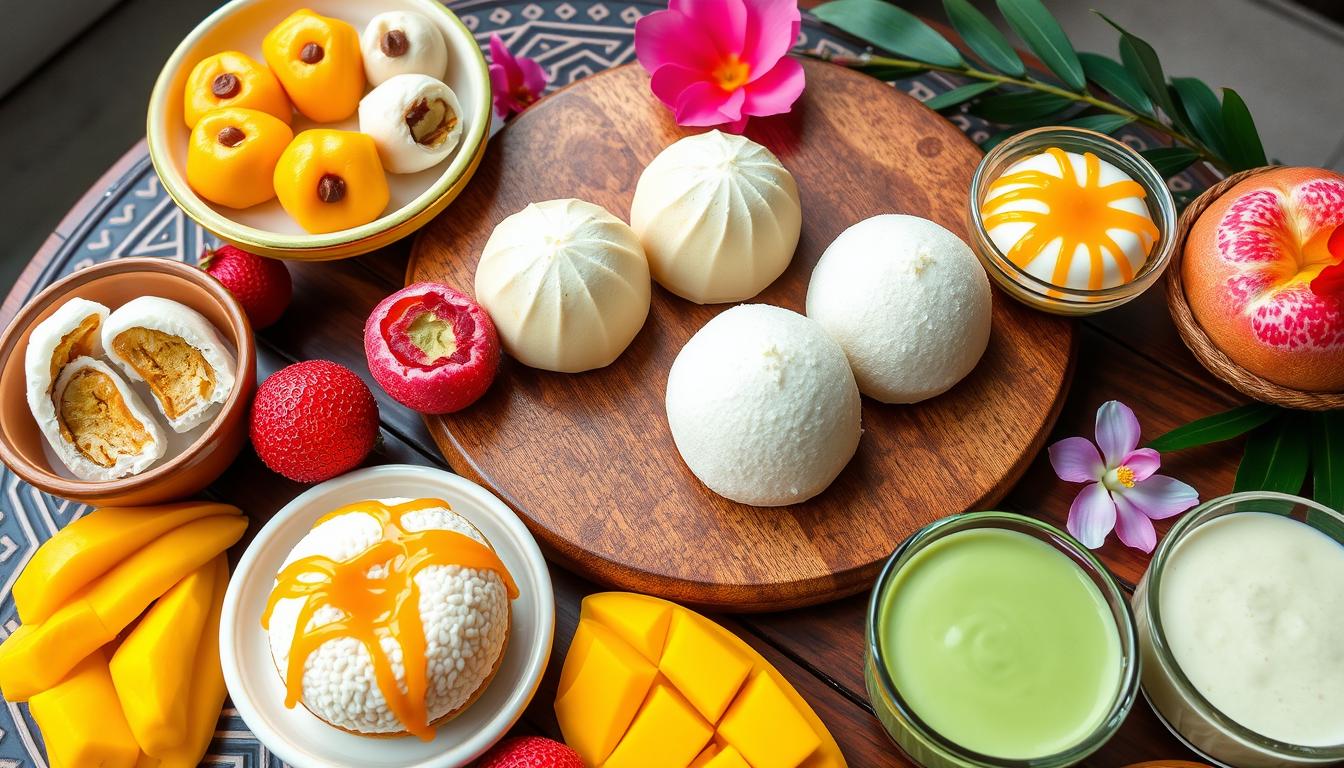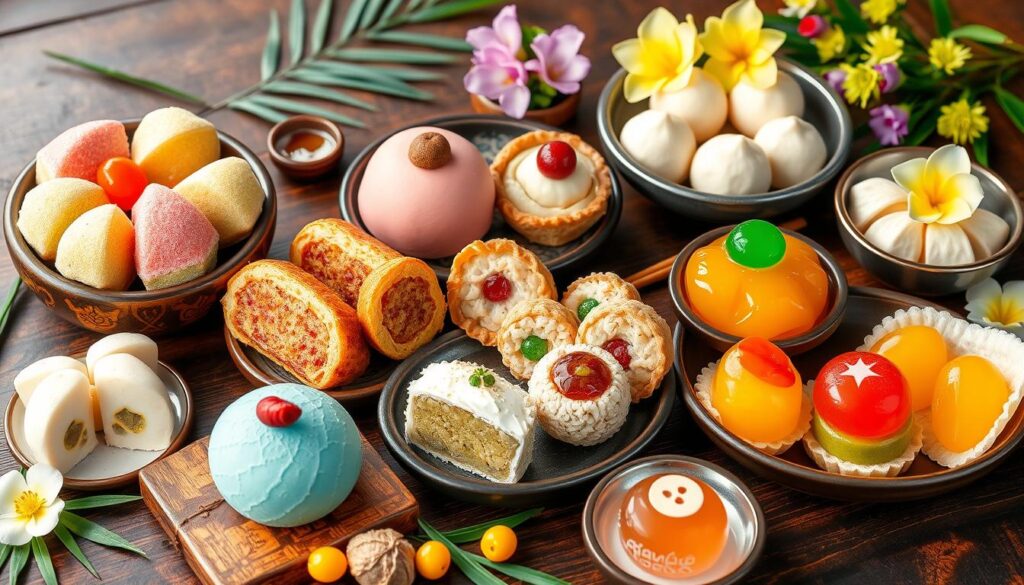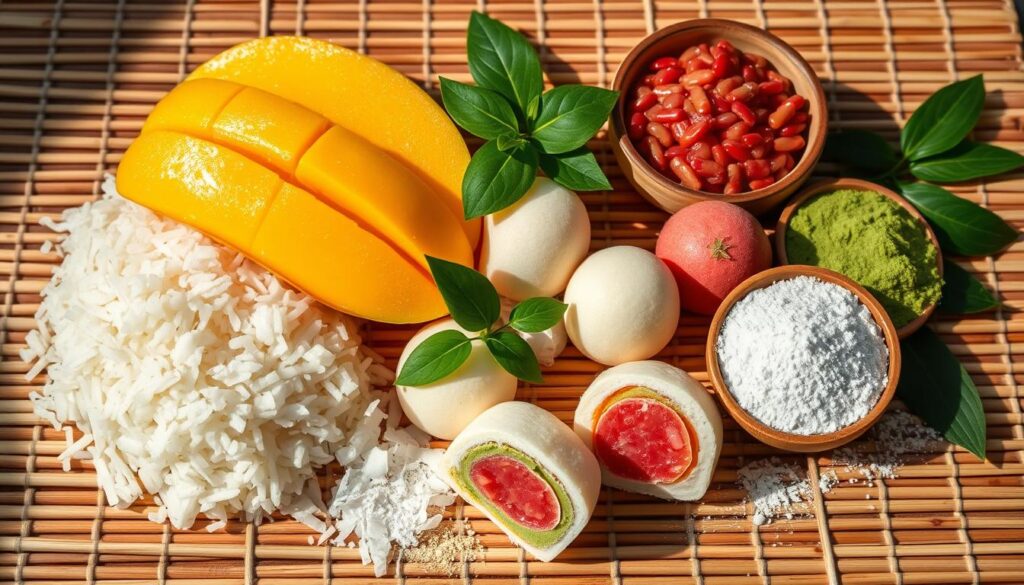My first taste of an Asian dessert was a delicate mochi from a local Japanese bakery. It changed how I saw sweetness. It showed me a world of texture, flavor, and culture beyond American treats. Asian desserts are a stunning world of flavors. Ingredients like rice, tropical fruits, and coconut make amazing sweets. From mochi’s chewiness to boba tea’s coolness, these treats take you on a flavor journey.
Exploring Asian desserts opens a door to a world of matcha sweets and coconut desserts. Each bite shares a story of family, tradition, and creativity. It’s a journey through generations of culinary art.
If you love desserts or just want to try something new, Asian treats are for you. They promise to open your eyes to new flavors. Get ready for a sweet adventure that will change how you see desserts.
1. Introduction to Asian Desserts
Asian desserts are a colorful mix of flavors, textures, and traditions. They surprise and delight your taste buds. From Tokyo’s streets to Hanoi’s markets, each place has its own sweet treats.
Asian sweets are very diverse. They use ingredients that might be new to Western tastes. You’ll find tropical fruits, red bean, and sesame desserts that show the region’s creativity and food traditions.
The Diversity of Asian Cuisines
Asian desserts show a wide range of flavors and traditions:
- Vietnamese treats focus on texture, not just sweetness
- Japanese sweets are known for their delicate flavors
- Southeast Asian desserts use unique ingredients like pandan and coconut
Regional Variations in Sweets
Every country has its own dessert style. For example, Chinese red bean desserts are different from Japanese sesame ones. Some interesting features include:
- Textures that range from chewy to crunchy
- Flavors that use ingredients like durian and taro
- Desserts that hold cultural importance during festivals
“Asian desserts are not just food—they’re edible stories of tradition and innovation.”
Exploring Asian sweets is like going on a culinary adventure. From tropical fruits in the Philippines to Japanese wagashi, these desserts turn simple ingredients into amazing experiences.
2. Popular Ingredients in Asian Desserts
Asian desserts are a journey of unique flavors and textures. They challenge what we think of desserts in the West. These sweets use special ingredients to make simple things into amazing rice flour desserts and sticky rice sweets.
Sticky Rice: The Versatile Sweet Ingredient
Sticky rice is key in many A-desserts. Its special texture and flavor-absorbing ability make it a standout in traditional sweets.
- Used in Thai Mango Sticky Rice
- Essential for Japanese Mochi
- Featured in Filipino Palitaw
Coconut Milk and Cream: Liquid Gold of Desserts
Coconut milk adds a rich, creamy touch to A-desserts. Its sweetness enhances dishes like Shwe Yin Aye from Myanmar. It also makes many traditional treats luxurious.
| Dessert | Country | Key Coconut Ingredients |
|---|---|---|
| Khanom Chan | Thailand | Coconut milk, rice flour |
| Halo-Halo | Philippines | Coconut pieces, milk |
| Red Bean Soup | China/Korea | Optional coconut milk |
Sweetened Bean Pastes: A Unique Flavor Profile
Bean pastes are another interesting ingredient in A-desserts. Red bean and mung bean pastes have a sweet, earthy taste. This might surprise people from the West.
“In A-desserts, beans are not just savory ingredients but can be transformed into delightful sweet experiences.”
From Japanese Mochi with sweet red bean paste to Chinese Fried Sesame Balls with lotus paste, these ingredients show the creativity of Asian dessert-making.
3. Iconic Asian Desserts You Must Try
A-desserts are a journey of flavors and textures. They show the creativity of Asian cuisine. From chewy mochi to sticky rice sweets, they will excite your taste buds.
Mochi: A Chewy Delight
Mochi is a beloved Asian dessert loved by many. It’s a soft, glutinous rice cake from Japan. It comes in many flavors, like red bean paste or fresh fruit.
Kue: Indonesian Sweet Treasures
In Indonesia, kue is a collection of small desserts. They are made in many ways, from steaming to baking. Each one shows the diversity of Indonesian cuisine.
Thai Sticky Rice with Mango: A Tropical Sensation
Mango sticky rice is a top Asian dessert. It mixes fragrant sticky rice, sweet mango, and coconut milk. It’s a perfect mix of textures and flavors.
| Dessert | Preparation Time | Difficulty | Servings |
|---|---|---|---|
| Mango Sticky Rice | 50 minutes | Easy | 4 servings |
| Strawberry Mochi | 45 minutes | Intermediate | 10 pieces |
| Sesame Balls | 60 minutes | Intermediate | 10 balls |
“Desserts are the fairy tales of the kitchen.” – Anonymous
Whether you love desserts or just want to try new things, these Asian sweets are a must. Each bite is a story of tradition, creativity, and culture.
4. Traditional versus Modern Asian Desserts
Asian desserts have changed a lot, mixing old traditions with new ideas. This journey through flavors and techniques is both fascinating and creative.
The world of Asian sweets is changing fast. Old recipes are getting new twists. Chefs are using global ingredients and new methods to make these treats.
Classic Recipes STILL Beloved
Traditional Asian desserts are loved by many. Some favorites include:
- Mochi with classic red bean filling
- Daifuku with traditional sweet paste
- Purin (Japanese custard pudding)
Innovative Fusion Desserts
Modern chefs are making exciting new desserts. Matcha sweets are very popular, turning old recipes into new favorites.
“Innovation in desserts is about respecting tradition while embracing creativity” – Chef Hiroshi Tanaka
New trends in Asian desserts are exciting. They include:
- Matcha cheesecake with unique texture
- Boba tea-inspired ice cream
- Souffle pancakes with unconventional toppings
The Japanese dessert market is full of innovation. Despite having less than 10% of China’s population, Japan has a big confectionery market. This is thanks to its deep culinary traditions and creative spirit.
5. Vegan and Gluten-Free Asian Desserts
Asian desserts offer a world of tasty options for those with dietary needs. Rice flour and coconut-based treats are great for vegans and those who can’t eat gluten.
Asian desserts now include many choices for different diets. They keep their cultural flavor but are now more inclusive. You’ll find many tasty options that are both healthy and traditional.
Plant-Based Asian Sweets
Vegan Asian desserts use amazing plant-based ingredients. Here are some yummy choices:
- Sweet Red Bean Soup: A traditional gluten-free dessert
- Coconut milk-based puddings
- Rice flour mochi with plant-based fillings
- Sesame seed balls made with alternative sweeteners
Naturally Gluten-Free Options
Many Asian desserts don’t have gluten, which is great for those with dietary restrictions.
| Dessert | Main Ingredients | Dietary Considerations |
|---|---|---|
| Eight Treasure Rice Pudding | Rice, fruits, nuts | Gluten-free, can be vegan |
| Nian Gao | Sweet rice cake | Naturally gluten-free |
| Fa Gao | Rice flour cake | Vegan, gluten-free options |
“Dietary restrictions don’t mean sacrificing delicious Asian desserts – they mean discovering new culinary adventures!” – Asian Dessert Experts
When making these desserts, you can change traditional recipes to fit your diet. Asian markets and specialty stores have ingredients that make vegan and gluten-free versions easy and tasty.
6. How to Make Asian Desserts at Home
Making Asian desserts at home is simpler than you might think. With a few key tools and some practice, you can make delicious sticky rice sweets and mochi. These can be just as good as those from specialty bakeries.
Essential Tools for Asian Baking
To begin your Asian desserts journey, you’ll need some special tools:
- Bamboo steamer for traditional recipes
- Rice cooker with sticky rice setting
- Silicone mochi mats
- Digital kitchen scale for precise measurements
- Non-stick baking sheets
Step-by-Step Recipes to Master
Exploring Asian desserts at home is a fun culinary adventure. Start with these easy recipes:
- Strawberry Mochi: A soft, chewy treat filled with fresh strawberries
- Thai Mango Sticky Rice: A classic dessert with sweet coconut notes
- Japanese Dango: Soft rice flour dumplings perfect for beginners
“Cooking Asian desserts is about passion, precision, and enjoying the process.” – Chef Mai Nguyen
Pro tip: Find specialty ingredients in local Asian grocery stores or online. Many items like sweet rice flour and ube are now in regular supermarkets.
7. Asian Desserts in American Culture
The world of American desserts has changed thanks to Asian treats. Now, boba tea shops and sweet spots are found everywhere. They’re making traditional Asian desserts a big hit in America.
Asian desserts have brought a tasty change to American food. New desserts are mixing old ways with new tastes. This is making food lovers excited about trying new things.
The Rise of Asian Dessert Shops
Asian dessert shops are popping up in cities and suburbs. They offer a wide range of sweets. You can find:
- Matcha sweets with unique flavors
- Boba tea in fun ways
- Mochi donuts that mix Japanese and American styles
- Rolled ice cream with Asian toppings
Popular Fusion Dessert Trends
Chefs are making desserts that stand out. Some cool trends are:
- Matcha cupcakes with almond buttercream
- Vietnamese iced coffee ice cream
- Milk bread cinnamon rolls with cool glazes
“Asian desserts are not just food—they’re a cultural journey on a plate.”
More people are trying these desserts. It shows America’s growing love for different foods. Whether you love food or just desserts, Asian sweets have something special for you.
8. Seasonal Asian Desserts to Celebrate
Asian desserts are deeply rooted in cultural traditions. Many sweets are tied to specific celebrations and seasonal moments. Your culinary journey through these treats reveals a rich tapestry of flavors and meanings.
Mooncakes for the Mid-Autumn Festival
Mooncakes are a quintessential example of seasonal Asian desserts. They symbolize family unity and are traditionally filled with red bean desserts or lotus seed paste. During the Mid-Autumn Festival, families gather to share these delicate treats under the moonlight.
- Traditional mooncake fillings include red bean paste
- Sesame desserts often accompany mooncake celebrations
- Each mooncake carries symbolic meaning of harmony
Traditional New Year Sweets
Lunar New Year brings special desserts across Asian cultures. From Chinese tang yuan (sweet rice balls) to Vietnamese bánh chưng, these sweets represent luck, prosperity, and family connections. Many feature sesame desserts or red bean fillings that are considered auspicious.
*”Food is our common ground, a universal experience.”* – James Beard
Your exploration of seasonal Asian desserts shows how food intertwines with cultural celebrations. It transforms simple ingredients into meaningful experiences that connect generations.
9. Healthier Alternatives to Classic Desserts
Asian desserts are a tasty way to enjoy sweets while staying healthy. By making traditional recipes healthier, you can make desserts that are both yummy and good for you.
Reducing Sugar in Recipes
It’s possible to make healthier desserts without losing flavor. Here are some tips to cut down on sugar:
- Replace refined sugar with natural fruit sweeteners
- Use coconut milk for natural richness
- Incorporate fresh tropical fruits for sweetness
- Follow the 80-20 rule for sugar consumption
Natural Sweetener Options
Try different ways to sweeten your desserts for better health:
| Sweetener | Sugar per Serving | Benefits |
|---|---|---|
| Vegan Nutella | 3.5g | Low-calorie chocolate alternative |
| Mango Nice Cream | 18.6g | Fruit-based dessert with natural sugars |
| Vegan Chocolate Truffles | 6g | Guilt-free chocolate experience |
“Healthy desserts can be a delicious way to nourish your body while satisfying your sweet tooth.”
By using these methods, you can enjoy desserts that are good for you. Remember, it’s all about balance and choosing the right ingredients for tasty and healthy desserts.
10. Resources for Further Exploration
Exploring Asian desserts is like going on a tasty journey. Whether you love matcha sweets or want to try mochi, there are many resources to help. Cookbooks like “The Japanese Baking Cookbook” by Maiko Kyogoku give you real recipes and cultural insights.
Online, you can find lots of great stuff for Asian dessert lovers. Food blogs like Just One Cookbook and Serious Eats have detailed recipes and guides. YouTube and TikTok also have videos that make complex desserts easy to follow.
For special ingredients, visit local Asian markets. H Mart and 99 Ranch Market have things like matcha powder and red bean paste. Going to cultural festivals and Asian bakeries can also give you new ideas and experiences.
Cookbooks on Asian Desserts
Look for cookbooks that give recipes and cultural background. Books by Niki Nakayama and Candice Kumai can teach you about Asian desserts. They also offer practical cooking tips.
Blogs and Online Communities
Join online communities to learn more about Asian desserts. Sites like Reddit’s r/JapaneseFood and Instagram hashtags like #AsianDesserts connect you with others. They share recipes, tips, and cultural insights.
Local Asian Markets and Ingredients
Visiting local Asian markets can change your dessert-making. These stores have authentic ingredients like special flours and unique flavor extracts. You won’t find these in regular grocery stores.
FAQ
What are some unique characteristics of Asian desserts?
Asian desserts are known for their diverse flavors and textures. They often use rice flour, coconut milk, and beans. Unlike Western sweets, they focus on balance and natural sweetness from fruits and sesame seeds.
What is mochi, and why is it so popular?
Mochi is a traditional Japanese dessert made from glutinous rice flour. It’s chewy and can be filled with red bean paste, fruits, or ice cream. Its popularity comes from its unique texture and versatility.
Are Asian desserts typically very sweet?
Not always. Asian desserts use less sugar, relying on the natural sweetness of ingredients. They focus on balance and texture, not just sweetness.
Can I make Asian desserts at home?
Absolutely! You can make many Asian desserts with common ingredients. Find specialty items in Asian grocery stores or supermarkets. Recipes like Strawberry Mochi and Boba Tea are easy to make at home.
What are some popular Asian dessert ingredients?
Key ingredients include sticky rice, coconut milk, and red bean paste. Sesame seeds, matcha, and tropical fruits also add unique flavors and textures.
Are there vegan or gluten-free Asian dessert options?
Yes! Many Asian desserts are naturally vegan or gluten-free. Vegan mochi and gluten-free halo-halo are just a few examples, catering to different diets.
Which Asian desserts are popular in the United States?
Boba tea, mochi donuts, and matcha desserts are popular in the U.S. Fusion desserts like Matcha Cupcakes and Vietnamese Iced Coffee Ice Cream are also gaining fans.
Are Asian desserts connected to specific celebrations?
Yes, many desserts are tied to cultural celebrations. Mooncakes are eaten during the Mid-Autumn Festival, and sweets are prepared for Lunar New Year. Desserts like Carrot Halwa are reserved for special holidays.
How can I learn more about Asian desserts?
Check out cookbooks like “Modern Asian Baking at Home”. Food blogs, online communities, and TikTok tutorials are also great resources. Visit local markets and bakeries, and attend cultural festivals to discover more.
What makes the texture of Asian desserts unique?
Texture is key in Asian desserts. Mochi is chewy, Korean bingsu has fine shaved ice, and Thai mango sticky rice is sticky. These textures offer a unique eating experience.



